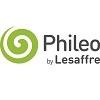
Content sponsored by:
Phileo by Lesaffre
Effect of selected yeast fraction on the growth of Clostridium perfringens: Quantitative determination of growth inhibition and adsorption capacity
Published: August 11, 2020
By: A. Riggi², E. Santovito¹, D.Greco¹, V. Marquis², R.Raspoet², V. Ascanio¹ &
G. Avantaggiato¹. ¹National Research Council, Institute of Sciences of Food Production (CNR-ISPA), Bari, Italy. ²Phileo-Lesaffre Animal Care, Marcq-en-Baroeul, France
To provide in vitro evidences on the antimicrobial effect of yeast cell wall (YCW), the effectiveness of YCW fractions in inhibiting the growth of several C. perfringens strains was quantitatively determined. The bacterium was grown in the presence of different YCW fractions at different concentration levels. The effect of YCW fractions on the growth parameters was analyzed. One product out of four materials was selected as the best candidate for C. perfringens inhibition. The selected product, at an optimal dosage of 1.25 mg/mL, increased the lag phase duration, and reduced the maximum growth rate and the final cell count in a significant manner with respect to the control. The adsorption of the pathogen to YCW was studied using the isotherm adsorption approach. The effect of YCW dosage, incubation time, and bacterial concentration on the adsorption was evaluated. The study proved that the product adsorbed C. perfringens cells in a dose and time dependent manner. Equilibrium isotherms showed that the cell adsorption onto the product was fast, stable over the time, and occurred with high affinity and capacity. The selected product sequestered up to 104 cells of C. perfringens per mg. To the best of our knowledge, this is the first report showing the in vitro efficacy of yeast fraction products to inhibit the growth of C. perfringens, and to reduce the culturable cells by an adsorption process. The in vitro approach proposed herein is as a powerful tool to study the adsorption of aerobic or anaerobic pathogens by eubiotics.
Keywords: yeast cell wall, antimicrobial, Clostridium, adsorption, feed additives
Content from the event:
Related topics:
Authors:
Phileo by Lesaffre
Phileo by Lesaffre
Phileo by Lesaffre
Recommend
Comment
Share
Sanluc International nv
26 de octubre de 2023
Indeed, a new and quite particular approach. I would also be interested to receive the full study or publication (luc@sanluc.be). The main question will raise how appropriate such IN VITRO data are for the field and in VIVO. Since it's extensively described that especially for Clostridium perfringens, data from in vitro studies have poor or no value for in VIVO, because Clostridium perfringens is anaerobic, houses in the distal part of the intestine and under particular conditions (interaction with host , microbiota and diet), impossible to mimic in the laboratory. Low M.I.C. values in a petri dish, might mean nothing in the animal.
I wonder if I read the numbers correctly (will verify in the detailed study), but 1,25 mg/ML would mean 1250 ppm, which is very high. If 104 cells are adsorbed by 1 mg of product, so LOG 2, then for a "normal" contamination of Clostridium Perfringens in the gut of LOG 8, (per gram intestinal content), one would need 1 KG product ?
Furthermore in the distal part of the intestine, around LOG11 "clostridium" types are present, many beneficial clusters, few pathogenic. How selective is the product to bind only the pathogenic ones ?
Thanks for the clarification and eventual correction.
I wonder if I read the numbers correctly (will verify in the detailed study), but 1,25 mg/ML would mean 1250 ppm, which is very high. If 104 cells are adsorbed by 1 mg of product, so LOG 2, then for a "normal" contamination of Clostridium Perfringens in the gut of LOG 8, (per gram intestinal content), one would need 1 KG product ?
Furthermore in the distal part of the intestine, around LOG11 "clostridium" types are present, many beneficial clusters, few pathogenic. How selective is the product to bind only the pathogenic ones ?
Thanks for the clarification and eventual correction.
Recommend
Reply
Cargill
21 de septiembre de 2023
Interesting evaluation. There is a published paper with this evaluation?
Recommend
Reply
Recommend
Reply

Would you like to discuss another topic? Create a new post to engage with experts in the community.





